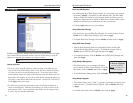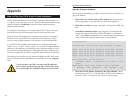
EtherFast Cable/DSL Routers
62
Instant Broadband Series
61
Step One: To Ping an IP Address
The first step to determining your ISP’s web and e-mail server address is to
ping its IP Address.
1. Power on the PC and the cable or DSL modem, and restore the net-
work configuration set by your ISP if you have since changed it.
2. Click Start, then Run, and type "command" to bring up the DOS win-
dow.
3. At the DOS command prompt, type "ping mail" (assuming that the
location for which you’re trying to find an IP address is configured as
“mail”). Press Enter. Information such as the following data, taken from
a ping of Microsoft Network’s email server, will be displayed.
C:\>ping mail
Pinging mail [24.53.32.4] with 32 bytes of data:
Reply from 24.53.32.4: bytes=32 time<10ms TTL=128
Reply from 24.53.32.4: bytes=32 time<10ms TTL=128
Reply from 24.53.32.4: bytes=32 time<10ms TTL=128
Reply from 24.53.32.4: bytes=32 time<10ms TTL=128
Ping statistics for 24.53.32.4:
Packets: Sent = 4, Received = 4, Lost = 0 (0%
loss),
Approximate round trip times in milli-seconds:
Minimum = 0ms, Maximum = 0ms, Average = 0ms
4. Write down the IP address returned by the ping command. (In the
example above: 24.53.32.4.) This IP address is the actual IP address of
the server “mail”, or any other word or value you have pinged.
Appendix
How to Ping Your ISP’s E-mail & Web Addresses
Almost all Internet addresses are configured with words and characters, i.e.,
www.linksys.com, www.yahoo.com, etc. However, these Internet addresses are
actually assigned to IP addresses, numerical values which are the true
addresses on the Internet.
For example, www.linksys.com is actually 206.135.116.3. Type it into your
web browser and you will bring up the Linksys home page every time.
However, IP and web addresses are sometimes long and hard to remember.
Because of this, certain ISPs will shorten their server addresses to single
words or codes on their customers’ web browser or e-mail configurations.
If your ISP’s e-mail and Web server addresses are configured with single
words (“www”, “e-mail”, “home”, “pop3”, etc.) instead of complete Internet
addresses or IP addresses, your Router may have problems sending or receiv-
ing email and accessing the Internet. This happens because your Router has
not been configured by your ISP to accept their abbreviated server addresses.
The solution is to find the true web addresses behind your ISP’s code words.
You can find these IP and web addresses of your ISP’s servers by “pinging”
them.
If you do not have your ISP’s web and e-mail IP addresses,
you must either get them from your ISP or follow these steps
prior to connecting your Cable/DSL Router to your network.


















